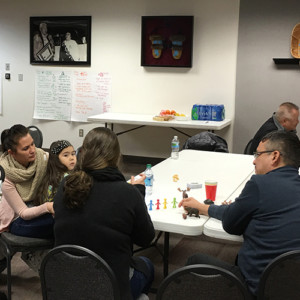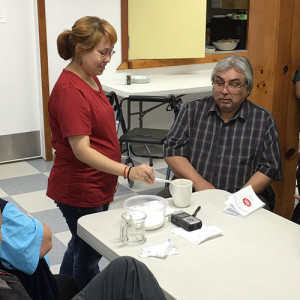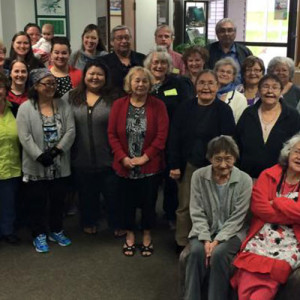1 hour, 15 minutes, and 51 seconds.
1. Technique “Agile“
- Why did we offer a WAYK workshop for IT professionals who belong to the Agile software development community?
- WAYK teaches “teacher-trainers”.
- WAYK is a pattern language; a mentoring language that (in an open source, ever-improving fashion) codifies the successful strategies involved in teaching and learning.
2. Technique “Chartering“
- Our highest value: the most rapid emergence of fluent proficiency in any skill, in any community.
3. Technique “Goal Conversation“
- We wanted to apply WAYK to something that might appear as a work practice in a dialect of Agile software development.
- We also wanted to train our “language hunters“, while we still had them in the workshop, to use their skills without hesitating.
4. Technique “Language Hunting“
- You need to learn to “language hunt” fluently before you can start applying the WAYK mentoring language to other skill domains (such as Agile).
- Evan thinks it takes a minimum of 1 to 1½ days, in an WAYK immersion workshop, for fluent “language hunters” to emerge.
5. Technique “Critical Mass“
- With 10 attendees at the workshop (we only had five), we could have vastly accelerated the workshop.
- The more people, the more dynamic the process of shifting “inner circle” and “lunatic fringe” by calling “Full“, and so on.
6. Technique “You go first“
- We “set-up” a pretend “language hunting” scenario for three spoken languages; Japanese, Chinuk Wawa, Norwegian.
- Anders, our Norwegian attendee, set a record for the fastest Chinuk Wawa hunt ever!
7. Technique “Teach a Teacher“
- We overheard some newbies say to another: “We’re going to teach you Norwegian now!”
8. Technique “Tea with Grandma“
- To prep for hunting spoken language, we “set-up” an archetypal “language hunting” scenario, with Evan pretending to be Deaf, ASL-fluent Grandma.
9. Technique “Shared Experience“
- Willem gives clues – “Grandma loves tea – and she doesn’t like coffee.”
10. Technique “Limit“
- Limiting the objects to the “tea” theme.
11. Technique “Obviously!“
- The need for a less-confusing tea mug.
- The hunt for a perfectly white mug.
- It’s all in the planning.
12. Technique “Set-up“
- Arranging the “hunting pack” around Grandma, without scaring her…
- Establishing a “limited” array of objects; one color, few materials.
- Grandma was nervous – the “angels” and “lunatic fringe” were arrayed about her in an intimidating fashion.
13. Technique “What’s that?“
- Anders kicks the conversation into gear, by asking the first question you ever want to ask in “language hunting“.
14. Technique “Full“
- Some of the hunters called “full” in front of Grandma, confusing her a bit. Also the rotation of “fringe” to “inner circle“, though perfect form during a WAYK game, during tea with Grandma tended to bewilder her.
15. Technique “Craig’s List“.
- They start building “craig’s lists” on their own.
16. Technique “Hunting Pack“
- It takes a lot of teamwork to trust that while others are hunting, you can be building “craig’s lists” in the background, and running a WAYK game to solidify your fluent proficiency.
17. Technique “Make me say No…“
- Dale triggers a correction response, by asking “is that a black spoon”? This gets Evan to say “No, that is a white spoon”, revealing the word for “white”.
18. Technique “Make me say Yes…“
- Dale then “sets-up” another round, to reveal the names of materials; paper, plastic, ceramic.
- “White” and “like” are very similar hand-signs; Dale thoroughly investigates whether he understood Evan correctly.
19. Technique “Set-up“
- Dale even pulls the word for “clear” out of Evan!
- Anders perfectly “sets-up” the question “where’s my bread?”, by “accidentally” dropping it under his chair.
- Michael “sets-up” a conversation about sweeteners to put in tea.
- Michael discovers the word “fake” – a very abstract concept! How did he get it in a conversation about “tea”?
20. Technique “Craig’s List“
- Michael decides to extend the colors “craig’s list” by hunting for “yellow”.
21. Technique “Hunting Pack“
- Evan and Willem wish they could take the “language hunters” they trained at this workshop with them on language revitalization programs. They’re really good. Sigh.
- The team then pretends to be on a plane-ride home from Grandma.
22. Technique “Organizing Principle“
- The team starts troubleshooting organizing the “craig’s lists“, using different themes.
23. Technique “Novice Listing“
- They needed to move on from just listing though…even if it was highly-skilled “craig’s listing“. Listing is a Novice behavior!
- They bumped it up to “Intermediate proficiency” by throwing the “craig’s lists” into a “want/have/give/take” conversation.
- Evan wishes he could have debriefed “Tea with Grandma” – important insights would have emerged, but we just didn’t have enough time.
24. Technique “the Walk“
- Critical group fluency emerged during the second morning’s “Walk“.
- Michael told a story about hang-gliding off the balcony. Whew!
25. Technique “Speed Dating“
- By applying techniques “Set-up“, “You go first“, and “Modeling”, we were determined to inspire “language hunting” after the workshop.
- This looked a lot like “speed dating” – a few paired “language hunting” games.
- We began by pretending Willem was a Russian-speaker wearing a “I Heart Speaking Russian” standing at the bank, with Evan next to him in line.
26. Technique “How do you say…?“
- If you have a common bridge language (such as English) in the beginning, don’t be afraid to use it for a little while.
- Evan’s first question to Willem’s Russian-speaker: “How do you say “What is that?” in Russian?”.
- His next question (while pointing at a red pen) “Well then, [in Russian] what is that?”.
27. Technique “Bridge Language“
- Elizabeth asks Evan (while paired with him, hunting his Chinuk Wawa), “Do you speak ASL?”. Evan can’t help but say “yes!”. Very cunning…
28. Technique “Agile“
- We applied it then to a practice that might be done by an Agile software developer (in this case, Michael).
- It would be very easy to talk theoretically about how one might apply it…but we were determined to use techniques “do something“, “modeling“, and “you go first“.
- We set a 15 minute time-box in which we needed to decided upon a “same conversation” to start with. And then: action!
29. Technique “Imagine You’re in a Cafe in Spain“ – a decelerator
- Don’t pretend to be where you want to be – go there! “Set-up” the real conversation (or as close to real as possible).
- Fortunately, our host Elisabeth designed Agilistry studio (our workshop space) to accurately simulate an Agile environment.






Hehe, can’t wait to hear it when i get the chance. <3
Another great podcast that makes me better at WAYK.
I still don’t get how to use WAYK for a non-language skill. It’s like you ran out of gas there. Oh, you did… 🙂
I also still feel a little uncertain about how to go beyond Want/Have/Give/Take with a language. I mention that because in both cases I haven’t actually done it. Again, actually doing WAYK is required to understand WAYK.
All in good time, I’m sure.
Jay-
Yeah, we almost did run out of gas!
You’ll kick yourself when we show you how to extend the game past want/have/give/take, and apply it to other skills. It’s like hearing the answer to a riddle; it’s only obvious after you hear it.
We do need to get a workshop on over there for you, in Port Townshend or Seattle, at some point. Hrm! If you fill it, we will come!
yrs,
Willem
I totally believe you, Willem. When I saw the first WAYK video, I was stunned. It was so simple. The emperor has no clothes, because the climate is mild. (Actually his outfit was carefully prepared to make him look naked.)
Then I tried to explain WAYK, but couldn’t get the message across, and decided that you have to play to get it.
I taught bicycle repair on Saturday (really) and was thinking about how to apply WAYK. The only thing I picked up on was my urge to explain lots of details that would have Sorry Charlie’d my student.